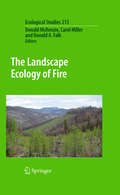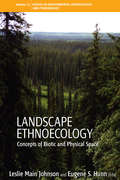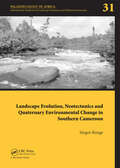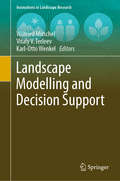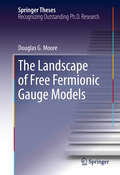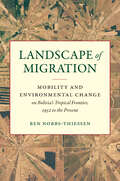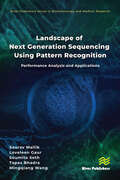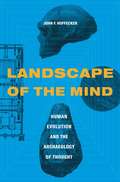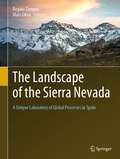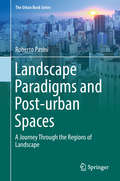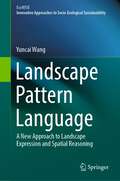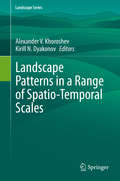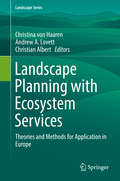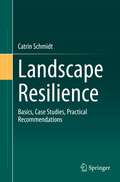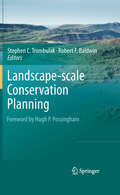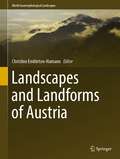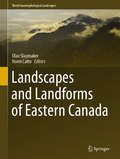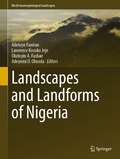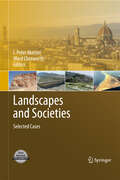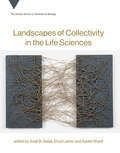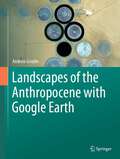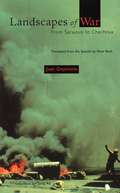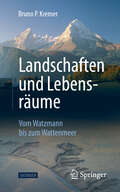- Table View
- List View
The Landscape Ecology of Fire
by Carol Miller Donald A. Falk Donald MckenzieGlobal warming is expected to change fire regimes, likely increasing the severity and extent of wildfires in many ecosystems around the world. What will be the landscape-scale effects of these altered fire regimes? Within what theoretical contexts can we accurately assess these effects? We explore the possible effects of altered fire regimes on landscape patch dynamics, dominant species (tree, shrub, or herbaceous) and succession, sensitive and invasive plant and animal species and communities, and ecosystem function. Ultimately, we must consider the human dimension: what are the policy and management implications of increased fire disturbance, and what are the implications for human communities?
Landscape Ethnoecology
by Leslie Main Johnson Eugene S. HunnAlthough anthropologists and cultural geographers have explored "place" in various senses, little cross-cultural examination of "kinds of place," or ecotopes, has been presented from an ethno-ecological perspective. In this volume, indigenous and local understandings of landscape are investigated in order to better understand how human communities relate to their terrestrial and aquatic resources. The contributors go beyond the traditional ecological knowledge (TEK) literature and offer valuable insights on ecology and on land and resources management, emphasizing the perception of landscape above the level of species and their folk classification. Focusing on the ways traditional people perceive and manage land and biotic resources within diverse regional and cultural settings, the contributors address theoretical issues and present case studies from North America, Mexico, Amazonia, tropical Asia, Africa and Europe.
Landscape Evolution, Neotectonics and Quaternary Environmental Change in Southern Cameroon: Palaeoecology of Africa Vol. 31, An International Yearbook of Landscape Evolution and Palaeoenvironments (Palaeoecology of Africa)
by Jürgen RungeFounded in 1966, the internationally recognized and acclaimed SeriesPalaeoecology of Africa publishes interdisciplinary scientific papers on landscape evolution and on former environments of the African continent. Beginning with topics such as changes in climate and vegetation cover, the papers expand horizons and interconnections to various typ
Landscape Genetics: Concepts, Methods, Applications
by Niko Balkenhol Samuel Cushman Andrew Storfer Lisette WaitsDespite the substantial interest in landscape genetics from the scientific community, learning about the concepts and methods underlying the field remains very challenging. The reason for this is the highly interdisciplinary nature of the field, which combines population genetics, landscape ecology, and spatial statistics. These fields have traditionally been treated separately in classes and textbooks, and very few scientists have received the interdisciplinary training necessary to efficiently teach or apply the diversity of techniques encompassed by landscape genetics. To address the current knowledge gap, this book provides the first in depth treatment of landscape genetics in a single volume. Specifically, this book delivers fundamental concepts and methods underlying the field, covering particularly important analytical methods in detail, and presenting empirical and theoretical applications of landscape genetics for a variety of environments and species. Consistent with the interdisciplinary nature of landscape genetics, the book combines an introductory, textbook like section with additional sections on advanced topics and applications that are more typical of edited volumes. The chapter topics and the expertise of the authors and the editorial team make the book a standard reference for anyone interested in landscape genetics. The book includes contributions from many of the leading researchers in landscape genetics. The group of scientists we have assembled has worked on several collaborative projects over the last years, including a large number of peer reviewed papers, several landscape genetics workshops at international conferences, and a distributed graduate seminar on landscape genetics. Based on the experiences gained during these collaborative teaching and research activities, the book includes chapters that synthesize fundamental concepts and methods underlying landscape genetics (Part 1), chapters on advanced topics that deserve a more in depth treatment (Part 2), and chapters illustrating the use of concepts and methods in empirical applications (Part 3). This structure ensures a high usefulness of the book for beginning landscape geneticists and experienced researchers alike, so that it has a broad target audience. At least one of the four co editors is involved in almost every chapter of the book, thereby ensuring a high consistency and coherency among chapters.
Landscape Modelling and Decision Support (Innovations in Landscape Research)
by Wilfried Mirschel Vitaly V. Terleev Karl-Otto WenkelThis book contributes to a deeper understanding of landscape and regional modelling in general, and its broad range of facets with respect to various landscape parameters. It presents model approaches for a number of ecological and socio-economic landscape indicators, and also describes spatial decision support systems (DSS), frameworks, and model-based tools, which are prerequisites for deriving sustainable decision and solution strategies for the protection of comprehensively functioning landscapes. While it mainly focuses on the latest research findings in regional modelling and DSS in Europe, it also highlights the work of scientists from Russia. The book is intended for landscape modellers, scientists from various fields of landscape research, university teaching staff, and experts in landscape planning and management, landscape conservation and landscape policy.
The Landscape of Free Fermionic Gauge Models
by Douglas G. MooreIn this thesis, the author describes the development of a software framework to systematically construct a particular class of weakly coupled free fermionic heterotic string models, dubbed gauge models. In their purest form, these models are maximally supersymmetric (N = 4), and thus only contain superpartners in their matter sector. This feature makes their systematic construction particularly efficient, and they are thus useful in their simplicity. The thesis first provides a brisk introduction to heterotic strings and the spin-structure construction of free fermionic models. Three systematic surveys are then presented, and it is conjectured that these surveys are exhaustive modulo redundancies. Finally, the author presents a collection of metaheuristic algorithms for searching the landscape for models with a user-specified spectrum of phenomenological properties, e. g. gauge group and number of spacetime supersymmetries. Such algorithms provide the groundwork for extended generic free fermionic surveys.
Landscape of Migration: Mobility and Environmental Change on Bolivia's Tropical Frontier, 1952 to the Present (Flows, Migrations, and Exchanges)
by Ben Nobbs-ThiessenIn the wake of a 1952 revolution, leaders of Bolivia's National Revolutionary Movement (MNR) embarked on a program of internal colonization known as the "March to the East." In an impoverished country dependent on highland mining, the MNR sought to convert the nation's vast "undeveloped" Amazonian frontier into farmland, hoping to achieve food security, territorial integrity, and demographic balance. To do so, they encouraged hundreds of thousands of Indigenous Bolivians to relocate from the "overcrowded" Andes to the tropical lowlands, but also welcomed surprising transnational migrant streams, including horse-and-buggy Mennonites from Mexico and displaced Okinawans from across the Pacific.Ben Nobbs-Thiessen details the multifaceted results of these migrations on the environment of the South American interior. As he reveals, one of the "migrants" with the greatest impact was the soybean, which Bolivia embraced as a profitable cash crop while eschewing earlier goals of food security, creating a new model for extractive export agriculture. Half a century of colonization would transform the small regional capital of Santa Cruz de la Sierra into Bolivia's largest city, and the diverging stories of Andean, Mennonite, and Okinawan migrants complicate our understandings of tradition, modernity, foreignness, and belonging in the heart of a rising agro-industrial empire.
Landscape of Next Generation Sequencing Using Pattern Recognition: Performance Analysis and Applications (River Publishers Series in Biotechnology and Medical Research)
by Saurav Mallik Loveleen Gaur Soumita Seth Tapas Bhadra Mingqiang WangThis book focuses on an eminent technology called next generation sequencing (NGS) which has entirely changed the procedure of examining organisms and will have a great impact on biomedical research and disease diagnosis. Numerous computational challenges have been brought on by the rapid advancement of large-scale next-generation sequencing (NGS) technologies and their application. The term ""biomedical imaging"" refers to the use of a variety of imaging techniques (such as X-rays, CT scans, MRIs, ultrasounds, etc.) to get images of the interior organs of a human being for potential diagnostic, treatment planning, follow-up, and surgical purposes. In these circumstances, deep learning, a new learning method that uses multi-layered artificial neural networks (ANNs) for unsupervised, supervised, and semi-supervised learning, has attracted a lot of interest for applications to NGS and imaging, even when both of these data are used for the same group of patients.The three main research phenomena in biomedical research are disease classification, feature dimension reduction, and heterogeneity. AI approaches are used by clinical researchers to efficiently analyse extremely complicated biomedical datasets (e.g., multi-omic datasets. With the use of NGS data and biomedical imaging of various human organs, researchers may predict diseases using a variety of deep learning models. Unparalleled prospects to improve the work of radiologists, clinicians, and biomedical researchers, speed up disease detection and diagnosis, reduce treatment costs, and improve public health are presented by using deep learning models in disease prediction using NGS and biomedical imaging. This book influences a variety of critical disease data and medical images.
The Landscape of Relativistic Stellar Explosions (Springer Theses)
by Anna Y. HoThis thesis reports the discovery of relativistic stellar explosions outside of the gamma ray band, using optical time domain surveys. It is well known that some massive stars end their lives with the formation of a compact object (a neutron star or black hole) that launches a relativistic jet detectable from earth as a burst of gamma rays. It has long been suspected, however, that gamma ray bursts are only the tip of the iceberg in a broad landscape of relativistic explosions, and so the results presented in this thesis represent a major breakthrough. Highlights of this thesis include: characterization of the first major new class of relativistic explosions in a decade; the discovery of abrupt end-of-life mass-loss in a surprisingly diverse range of stars; and the routine discovery of afterglow emission and several events that may represent baryonically dirty jets or jets viewed slightly off axis. These discoveries necessitated the solution of difficult technical challenges such as the identification of rare and fleeting “needles” in a vast haystack of time-varying phenomena in the night sky, and responding to discoveries within hours to obtain data across the electromagnetic spectrum from X-rays to radio wavelengths.
Landscape of the Mind: Human Evolution and the Archaeology of Thought
by John HoffeckerIn Landscape of the Mind, John F. Hoffecker explores the origin and growth of the human mind, drawing on archaeology, history, and the fossil record. He suggests that, as an indirect result of bipedal locomotion, early humans developed a feedback relationship among their hands, brains, and tools that evolved into the capacity to externalize thoughts in the form of shaped stone objects. When anatomically modern humans evolved a parallel capacity to externalize thoughts as symbolic language, individual brains within social groups became integrated into a "neocortical Internet," or super-brain, giving birth to the mind.Noting that archaeological traces of symbolism coincide with evidence of the ability to generate novel technology, Hoffecker contends that human creativity, as well as higher order consciousness, is a product of the superbrain. He equates the subsequent growth of the mind with human history, which began in Africa more than 50,000 years ago. As anatomically modern humans spread across the globe, adapting to a variety of climates and habitats, they redesigned themselves technologically and created alternative realities through tools, language, and art. Hoffecker connects the rise of civilization to a hierarchical reorganization of the super-brain, triggered by explosive population growth. Subsequent human history reflects to varying degrees the suppression of the mind's creative powers by the rigid hierarchies of nationstates and empires, constraining the further accumulation of knowledge. The modern world emerged after 1200 from the fragments of the Roman Empire, whose collapse had eliminated a central authority that could thwart innovation. Hoffecker concludes with speculation about the possibility of artificial intelligence and the consequences of a mind liberated from its organic antecedents to exist in an independent, nonbiological form.
The Landscape of the Sierra Nevada: A Unique Laboratory of Global Processes in Spain
by Regino Zamora Marc OlivaThis book covers the landscape, geography and environment of the Sierra Nevada in Spain. The Sierra Nevada hosted the last glaciers in southern Europe. Today, it is one of the most important centers of plant diversity in the western Mediterranean and one of the most outstanding in Europe. This massif has ideal conditions to analyze past environments as well as the effects of global change on ecosystems. This can be seen in the large number of projects that are being conducted within the umbrella of the Sierra Nevada Global Change Observatory. This book summarizes all the scientific knowledge available about this massif, from the geomorphological and ecological perspectives to the recent spatial adaptive management and Open Science initiatives. Focusing on the very sensitive mountain environment of Sierra Nevada, the book intends to be a reference for many people interested in mountain processes. The audience would include scientists from all disciplines, but it would also target on an audience beyond the academia (territorial managers, environmentalists, mountaineers, politicians, technicians, etc.).
Landscape Paradigms and Post-urban Spaces: A Journey Through the Regions of Landscape (The Urban Book Series)
by Roberto PasiniThis book presents: 1) an urban-studies panorama on the emergence of a built/landscape continuum following the anthropic expansion at the geographic scale and the consequent demise of the city/country divide; 2) an in-depth theoretical analysis of disparate landscape constructs, culminating in the proposal of a comprehensive spatial paradigm addressing both manmade and natural contexts; 3) the in-situ transcription of the proposed spatial paradigm into a landscape installation implementing a territorial narrative in the Sierra Madre Oriental of Mexico. Foreword by Peter G. Rowe and afterword by Elisa C. Cattaneo.By virtue of its openness, fluidity, and volatility, fluctuating between heterogeneity and diversity, today’s built/landscape continuum exhibits analogies with distinct notions of landscape. The book determines an open-ended classification of contemporary space-making strategies exceeding the urban and metropolitan ambit, through a comparative anatomy of global case studies ranging from hard to soft: geotechnics or applied geographies, machinic micro-ecologies, aesthetic prostheses for operative metabolism, cybernetic utopias, atmospheric assemblages, psychic spheres, creole horizons, semiotic landscapes, geopolitical landscapes, geophilosophical excavations. The proposed spatial paradigm, accommodating aggregates of artificial and living systems, physical and mental spaces, and machinic and cultural landscapes, intends to reconcile the traditionally opposed ‘scientific-cognitive-metabolist’ and ‘cultural-geophilosophical-territorialist’ visions of the landscape. The resulting model transcends the exhausted myths of urban space, metropolitanism, and their filiations, in favor of a new form of urbanity and its attributes. Parts of the work were developed in the frame of research projects of Universidad de Monterrey and Parque Ecológico Chipinque and the IDAUP of UniFE and Polis.The target audience of the book is researchers, teachers, and advanced students engaged in landscape and urban studies with a prevalent focus on theory. The book can also benefit professional and institutional audiences looking for ethical/methodological orientation.
Landscape Pattern Language: A New Approach to Landscape Expression and Spatial Reasoning (EcoWISE)
by Yuncai WangThis book presents a landscape pattern language framework for describing landscape spaces and offers a new approach to landscape expression and spatial reasoning. In addition to describing a conceptual model of landscape pattern language and its inner logical connections, the book discusses the functionality of landscape pattern language from both local and universal perspectives—effectively demonstrating that it can be used to highlight the individuality and characteristics of landscape space shaping. Given its scope, the book offers a valuable resource for all graduate students, lecturers, researchers, and practitioners in the areas of landscape architecture, landscape planning, and regional planning, especially ecological planning and design.
Landscape Patterns in a Range of Spatio-Temporal Scales (Landscape Series #26)
by Alexander V. Khoroshev Kirill N. DyakonovThis book presents the polycentric and multiscale view of landscape which has been developed in Russia within a framework of physical geography since the early twentieth century. The authors develop the ideas of hierarchical organization of a landscape and strong relationships between abiotic and biotic components with equal attention to both vertical fluxes and lateral transfer. Three-dimensional representation of landscape involves strong emphasis on abiotic drivers of pattern development including relief, geological structures and runoff. The objective of this book is to demonstrate the multiplicity of models and multiscale approach to description and explanation of landscape pattern, functioning, dynamics, and evolution. The contributions deal with various hierarchical levels ranging from within-unit interior variability to between-units interaction at landscape level, as well as regional and supra-regional zonal patterns. Divided into 8 clear parts, the 28 chapters treat spatial pattern in one of the following aspects: indicator of actual matter and energy flows control over actual processes including disturbance expansion as well as determinant of future development indicator of genesis and prerequisite for future trends driver for short-term dynamics of processes response to climatic and anthropogenic influences factor of settlement network and land use adaptation at various historical epochs framework for actual land use spatial arrangement. This contributed volume is written for researchers and students in the field of landscape ecology, physical geography, environmental impact assessment, and ecological planning.
Landscape Planning with Ecosystem Services: Theories and Methods for Application in Europe (Landscape Series #24)
by Christina Von Haaren Andrew A. Lovett Christian AlbertHuman well-being depends in many ways on maintaining the stock of natural resources which deliver the services from which human’s benefit. However, these resources and flows of services are increasingly threatened by unsustainable and competing land uses. Particular threats exist to those public goods whose values are not well-represented in markets or whose deterioration will only affect future generations. As market forces alone are not sufficient, effective means for local and regional planning are needed in order to safeguard scarce natural resources, coordinate land uses and create sustainable landscape structures. This book argues that a solution to such challenges in Europe can be found by merging the landscape planning tradition with ecosystem services concepts. Landscape planning has strengths in recognition of public benefits and implementation mechanisms, while the ecosystem services approach makes the connection between the status of natural assets and human well-being more explicit. It can also provide an economic perspective, focused on individual preferences and benefits, which helps validate the acceptability of environmental planning goals. Thus linking landscape planning and ecosystem services provides a two-way benefit, creating a usable science to meet the needs of local and regional decision making. The book is structured around the Driving forces-Pressures-States-Impacts-Responses framework, providing an introduction to relevant concepts, methodologies and techniques. It presents a new, ecosystem services-informed, approach to landscape planning that constitutes both a framework and toolbox for students and practitioners to address the environmental and landscape challenges of 21st century Europe.
Landscape Resilience: Basics, Case Studies, Practical Recommendations
by Catrin SchmidtThis book explains what makes landscapes resilient. Why are some landscapes able to recover quickly from disruptive events or crises, while others are completely thrown off balance for the foreseeable future? The author sets out in search of the influencing factors and conditional structures of landscape resilience and not only evaluates the current state of the art, but also explores landscapes around the globe that could not be more contrasting: from arid agricultural landscapes to boreal forest landscapes, from atolls to saline landscapes, from terraced landscapes to cities. Just as diverse as the landscape types are the factors considered that can put landscapes under stress. However diverse the case studies are in detail, their fascinating mosaic shows at the same time that there are overarching principles that can be used to increase the resilience of landscapes in a targeted way, so that landscapes emerge from crises strengthened rather than weakened. This book is a translation of the original German 1st edition Landschaftliche Resilienz by Catrin Schmidt, published by Springer-Verlag GmbH Germany, part of Springer Nature in 2020. The translation was done with the help of artificial intelligence (machine translation by the service DeepL.com). A subsequent human revision was done primarily in terms of content, so that the book will read stylistically differently from a conventional translation. Springer Nature works continuously to further the development of tools for the production of books and on the related technologies to support the authors.
Landscape-scale Conservation Planning
by Robert Baldwin Stephen C. TrombulakThis book applies the latest thinking and techniques of systematic conservation planning to the issues that arise in protecting ecosystem pattern and process in human-dominated landscapes such as seascapes, multiple countries and conservation targets.
Landscapes and Landforms of Austria (World Geomorphological Landscapes)
by Christine Embleton-HamannThis book intends to identify and publicize the unique features of Austrian geomorphology. In a country, which stretches from the core of the European Alps to the Hungarian plain, there is huge variety of landforms and landscapes. This book reveals that variety. Part 1 sets the context of the Austrian landscape as a whole. Part 2 is the core of the volume and comprises a careful selection of the most outstanding landscapes in Austria. Each of the chapters results from detailed research conducted by an author over many years. Austria’s landscapes are especially attractive because of the great variety of topographic slopes, geologic foundations and the special landscape legacy from the Quaternary period. Glacial and Karst landscapes dominate, but there are superb examples of granite weathering landscapes and geologically recent volcanism.The book is lavishly illustrated with about 350 color images and is securely based on scientific scholarship.
Landscapes and Landforms of Eastern Canada (World Geomorphological Landscapes)
by Norm Catto Olav SlaymakerThis critical book focuses on the geomorphological landscapes of eastern Canada and provides a companion volume to “Landscapes and Landforms of Western Canada” (2017). There are a number of unique characteristics of eastern Canada’s landscapes, notably its magnificent coastlines, the extraordinary variety and extent of wetlands, the huge Great Lakes-St. Lawrence basin, the high incidence of meteorite craters, the spectacular Niagara Falls, urban karst in Montreal and Ottawa, youthful, glaciated karst in Ontario, Newfoundland, Quebec and Nova Scotia, the ubiquitous permafrost terrain of Nunavut, Labrador and northern Quebec and the magnificent arctic fjords and glaciers. Looking at coastlines, the tidal extremes of the Bay of Fundy are world renowned; the structural complexity of the island of Newfoundland is less well known, but produces an astounding variety of coastlines in close succession; the arctic fjordlands of Baffin and Ellesmere islands and the extravagant raised beaches of Hudson Bay bear comparison with the classic fjords of Norway and the Baltic Sea raised beaches. As for wetlands, there are distinctive Arctic, Subarctic, Boreal, Eastern Temperate and Atlantic wetlands, and their extent is second only to those of Russia. In the Hudson and James Bay regions, between 75-100% of the terrestrial surface is comprised of wetlands. One of North America’s largest river basins, the Great Lakes-St. Lawrence basin, has its source in Minnesota, straddles the USA-Canada border and debouches into Quebec as the St. Lawrence River and evolves through its estuary into the Gulf of St. Lawrence, a journey of almost 5,000 km. As far as meteorite craters are concerned, 10% of the world’s total are located in eastern Canada, including some of the largest and most complex landforms. They are preserved preferentially in the ancient Shield terrain of Quebec. Finally, the three million km² of permafrost controlled relief in eastern Canada serves as a reminder of the vulnerability of eastern Canada’s landscapes to climate change. Effects of warming are expressed through thawing of the permafrost, disruption of transportation corridors and urban construction problems, ever-present geomorphic hazards.
Landscapes and Landforms of Nigeria (World Geomorphological Landscapes)
by Adetoye Faniran Lawrence Kosoko Jeje Olutoyin A. Fashae Adeyemi O. OlusolaThe book deals with the most striking landscapes and landforms of Nigeria. Attention is paid to the diversity of geomorphic features found in the country, from the coast to the extreme north, approached geographically at the national, regional and local scales, with a view to highlight the combined influence of geological, climatic, biotic and anthropogenic influences, as well as geoheritage potentials. The topics and sites described range from the mainly depositional coastal lagoons and inlets, the most prominent of which is the oil rich Niger Delta, characterized by the mangrove and rain forest, both of which have been seriously modified by human impact; through the coastal lowlands and associated hill country, with derived, deciduous and dry forest vegetation; the very prominent Niger/Benue Trough and associated features; the savanna-semi desert covered high plains of the north and the Chad Basin, each of which features spectacular landscapes and landforms, including human-made forms such as cities and cityscapes. The book provides the readers with the opportunity to explore the variety of Nigerian landscapes and landforms through informative texts illustrated with color maps and photos: it will be relevant to scientists/scholars as well as others interested in the geology, physical geography, geomorphology, landscape, tourism and other geoheritage-related information about the country.
Landscapes and Societies
by I. Peter Martini Ward ChesworthThis book contains case histories intended to show how societies and landscapes interact. The range of interest stretches from the small groups of the earliest Neolithic, through Bronze and Iron Age civilizations, to modern nation states. The coexistence is, of its very nature reciprocal, resulting in changes in both society and landscape. In some instances the adaptations may be judged successful in terms of human needs, but failure is common and even the successful cases are ephemeral when judged in the light of history. Comparisons and contrasts between the various cases can be made at various scales from global through inter-regional, to regional and smaller scales. At the global scale, all societies deal with major problems of climate change, sea-level rise, and with ubiquitous problems such as soil erosion and landscape degradation. Inter-regional differences bring out significant detail with one region suffering from drought when another suffers from widespread flooding. For example, desertification in North Africa and the Near East contrasts with the temperate countries of southern Europe where the landscape-effects of deforestation are more obvious. And China and Japan offer an interesting comparison from the standpoint of geological hazards to society - large, unpredictable and massively erosive rivers in the former case, volcanoes and accompanying earthquakes in the latter. Within the North African region localized climatic changes led to abandonment of some desertified areas with successful adjustments in others, with the ultimate evolution into the formative civilization of Egypt, the "Gift of the Nile". At a smaller scale it is instructive to compare the city-states of the Medieval and early Renaissance times that developed in the watershed of a single river, the Arno in Tuscany, and how Pisa, Siena and Florence developed and reached their golden periods at different times depending on their location with regard to proximity to the sea, to the main trunk of the river, or in the adjacent hills. Also noteworthy is the role of technology in opening up opportunities for a society. Consider the Netherlands and how its history has been formed by the technical problem of a populous society dealing with too much water, as an inexorably rising sea threatens their landscape; or the case of communities in Colorado trying to deal with too little water for farmers and domestic users, by bringing their supply over a mountain chain. These and others cases included in the book, provide evidence of the successes, near misses and outright failures that mark our ongoing relationship with landscape throughout the history of Homo sapiens. The hope is that compilations such as this will lead to a better understanding of the issue and provide us with knowledge valuable in planning a sustainable modus vivendi between humanity and landscape for as long as possible. Audience: The book will interest geomorphologists, geologists, geographers, archaeologists, anthropologists, ecologists, environmentalists, historians and others in the academic world. Practically, planners and managers interested in landscape/environmental conditions will find interest in these pages, and more generally the increasingly large body of opinion in the general public, with concerns about Planet Earth, will find much to inform their opinions. Extra material: The color plate section is available at http://extras.springer.com
Landscapes of Collectivity in the Life Sciences (Vienna Series in Theoretical Biology #20)
by Snait Gissis Ehud Lamm Ayelet ShavitBroad perspective on collectivity in the life sciences, from microorganisms to human consensus, and the theoretical and empirical opportunities and challenges. Many researchers and scholars in the life sciences have become increasingly critical of the traditional methodological focus on the individual. This volume counters such methodological individualism by exploring recent and influential work in the life sciences that utilizes notions of collectivity, sociality, rich interactions, and emergent phenomena as essential explanatory tools to handle numerous persistent scientific questions in the life sciences. The contributors consider case studies of collectivity that range from microorganisms to human consensus, discussing theoretical and empirical challenges and the innovative methods and solutions scientists have devised. The contributors offer historical, philosophical, and biological perspectives on collectivity, and describe collective phenomena seen in insects, the immune system, communication, and human collectivity, with examples ranging from cooperative transport in the longhorn crazy ant to the evolution of autobiographical memory. They examine ways of explaining collectivity, including case studies and modeling approaches, and explore collectivity's explanatory power. They present a comprehensive look at a specific case of collectivity: the Holobiont notion (the idea of a multi-species collective, a host and diverse microorganisms) and the hologenome theory (which posits that the holobiont and its hologenome are a unit of adaption). The volume concludes with reflections on the work of the late physicist Eshel Ben-Jacob, pioneer in the study of collective phenomena in living systems. Contributors Oren Bader, John Beatty, Dinah R. Davison, Daniel Dor, Ofer Feinerman, Raghavendra Gadagkar, Scott F. Gilbert, Snait B. Gissis, Deborah M. Gordon, James Griesemer, Zachariah I. Grochau-Wright, Erik R. Hanschen, Eva Jablonka, Mohit Kumar Jolly, Anat Kolumbus, Ehud Lamm, Herbert Levine, Arnon Levy, Xue-Fei Li, Elisabeth A. Lloyd, Yael Lubin, Eva Maria Luef, Ehud Meron, Richard E. Michod, Samir Okasha, Simone Pika, Joan Roughgarden, Eugene Rosenberg, Ayelet Shavit, Yael Silver, Alfred I. Tauber, Ilana Zilber-Rosenberg
Landscapes of the Anthropocene with Google Earth
by Andrew GoudieThis book considers the meaning of the term, considers the value and characteristics of Google Earth, and discusses the main driving forces of landscape change. Google Earth provides a means whereby one can identify changes in the landscapes of Earth over recent decades. This has been a time of great human activity, and landscapes have been transformed as a result of such factors as land use and land-cover change, climate change, the intensive harnessing of new energy sources, population pressures, and globalization. Many geologists now believe that the whole Earth System is being changed and that there is thus a need to introduce the concept of the Anthropocene. It then looks at specific landscape types, including rivers, coasts, lakes, deserts, tundra, and glaciers.
Landscapes of War: From Sarajevo to Chechnya
by Juan Goytisolo Peter BushAn incisive examination of the tensions that exist between the West and Islamic societies of Europe, North Africa, and the Middle East. Provides rich historical analysis and reportage of life in four explosive war-zones: Sarajevo, Algeria, the West Bank and Gaza, and Chechnya. Translated by Peter Bush.
Landschaften und Lebensräume: Vom Watzmann bis zum Wattenmeer
by Bruno P. KremerIn allen seinen Teilgebieten weist Mitteleuropa eine beachtliche natur- und kulturlandschaftliche Vielfalt auf, die unser Erleben draußen enorm bereichert. Vom Hochgebirge bis zur Küste laden äußerst unterschiedliche Lebensraum-Ensembles zur aktiven Erkundung ein. Erfahren Sie in diesem Buch u.a. · wie die zurückliegenden Eiszeiten Gletschertore geschaffen und die Landschaft im Voralpenland modelliert haben · wo in Norddeutschland noch vor etwa 10000 Jahren die Vereisungsgrenzen verliefen · was entlang von Fließgewässern vom kleinen Gebirgsbach bis zum großen Strom zu beobachten ist · weshalb auch die Stillgewässer nicht nur der großen Seenplatten äußerst erlebniswerte Lebensräume darstellen · warum auch vom Menschen geschaffene Ersatzstandorte wie Ackersäume und Wiesen wertvolle Biotope darstellen · was in den Nationalparkgebieten an der Nordseeküste Erlebniswertes auf Sie wartet Dieses Buch bietet mit seinen sorgsam ausgewählten Fallbeispielen zwar keine enzyklopädische Komplettübersicht, aber doch eine animativ-themenreiche Anregung zum aktiveren Erleben und Wahrnehmen der besonderen Facetten unseres heimischen Ambientes.
